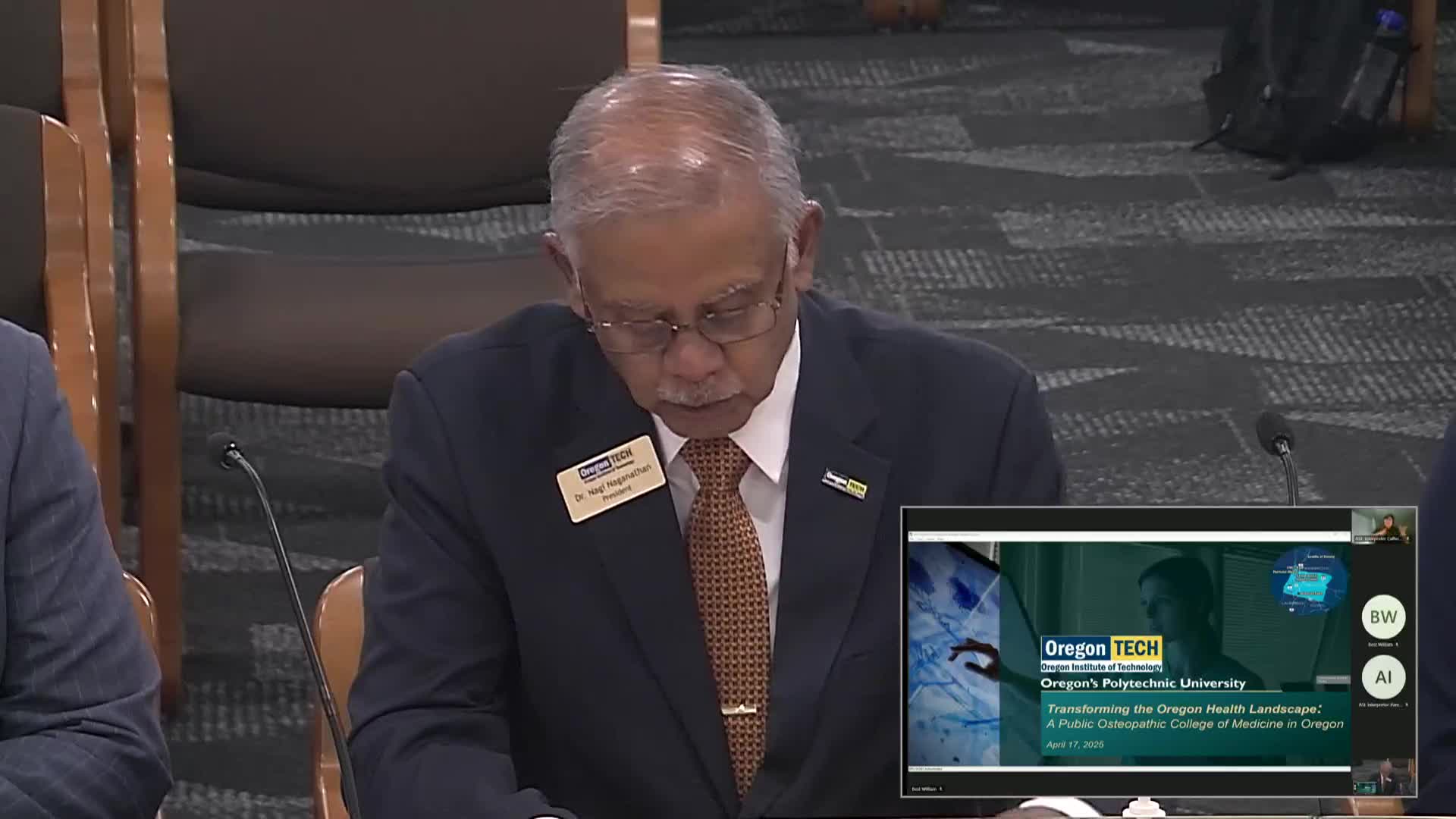Oregon Tech proposes state’s first public osteopathic medical school to improve healthcare access
April 17, 2025 | Higher Education, House of Representatives, Committees, Legislative, Oregon
This article was created by AI summarizing key points discussed. AI makes mistakes, so for full details and context, please refer to the video of the full meeting. Please report any errors so we can fix them. Report an error »

In a recent meeting of the Oregon House Committee on Higher Education and Workforce Development, significant discussions centered on the critical issue of healthcare access in the state. The meeting highlighted the alarming shortage of primary care providers, particularly in rural areas, which affects millions of Oregonians.
The meeting began with a presentation from Oregon Tech representatives, who emphasized the urgent need to address the deteriorating healthcare landscape. They shared personal anecdotes illustrating the struggles faced by families in rural Oregon, where access to basic healthcare services can be severely limited. For instance, residents often find themselves traveling long distances for care, with some requiring airlifts for routine medical issues. This situation has created what was described as a "healthcare desert," impacting approximately 2.5 million Oregonians.
Oregon Tech proposed a solution: the establishment of the state's first public osteopathic medical school. This initiative aims to increase the number of primary care providers in Oregon, particularly in underserved areas. The university's commitment to community engagement is a foundational aspect of this initiative, which they believe could significantly improve health outcomes across the state.
Galen Marr, the executive director of health and wellness at Oregon Tech, presented data showing stark health inequities between rural and urban regions. He noted that rural areas experience lower life expectancies and higher rates of premature death and suicide. The Oregon Health Authority has set a goal to eliminate these health disparities by 2030, but current trends indicate that the situation may worsen without immediate action.
David Cobble, CEO of Sky Lakes Medical Center in Klamath Falls, echoed these concerns, highlighting the challenges faced by rural healthcare systems. He pointed out that Klamath County has only one primary care provider for every 2,000 residents, compared to the statewide average of one for every 1,300. Cobble warned that the projected shortage of primary care physicians could reach between 20,000 and 40,000 by 2036, exacerbated by retirements and increasing demand due to an aging population.
The committee's discussions underscored the need for a coordinated response to the healthcare workforce crisis in Oregon. The proposed osteopathic medical school is seen as a vital step toward building a sustainable healthcare workforce that can meet the needs of all Oregonians, particularly those in rural communities.
As the meeting concluded, the urgency of the situation was clear. With the healthcare landscape in Oregon facing significant challenges, stakeholders are calling for immediate action to ensure that all residents have access to the care they need. The proposed initiatives represent a hopeful step forward in addressing these pressing issues, but the path ahead will require continued collaboration and commitment from all involved.
The meeting began with a presentation from Oregon Tech representatives, who emphasized the urgent need to address the deteriorating healthcare landscape. They shared personal anecdotes illustrating the struggles faced by families in rural Oregon, where access to basic healthcare services can be severely limited. For instance, residents often find themselves traveling long distances for care, with some requiring airlifts for routine medical issues. This situation has created what was described as a "healthcare desert," impacting approximately 2.5 million Oregonians.
Oregon Tech proposed a solution: the establishment of the state's first public osteopathic medical school. This initiative aims to increase the number of primary care providers in Oregon, particularly in underserved areas. The university's commitment to community engagement is a foundational aspect of this initiative, which they believe could significantly improve health outcomes across the state.
Galen Marr, the executive director of health and wellness at Oregon Tech, presented data showing stark health inequities between rural and urban regions. He noted that rural areas experience lower life expectancies and higher rates of premature death and suicide. The Oregon Health Authority has set a goal to eliminate these health disparities by 2030, but current trends indicate that the situation may worsen without immediate action.
David Cobble, CEO of Sky Lakes Medical Center in Klamath Falls, echoed these concerns, highlighting the challenges faced by rural healthcare systems. He pointed out that Klamath County has only one primary care provider for every 2,000 residents, compared to the statewide average of one for every 1,300. Cobble warned that the projected shortage of primary care physicians could reach between 20,000 and 40,000 by 2036, exacerbated by retirements and increasing demand due to an aging population.
The committee's discussions underscored the need for a coordinated response to the healthcare workforce crisis in Oregon. The proposed osteopathic medical school is seen as a vital step toward building a sustainable healthcare workforce that can meet the needs of all Oregonians, particularly those in rural communities.
As the meeting concluded, the urgency of the situation was clear. With the healthcare landscape in Oregon facing significant challenges, stakeholders are calling for immediate action to ensure that all residents have access to the care they need. The proposed initiatives represent a hopeful step forward in addressing these pressing issues, but the path ahead will require continued collaboration and commitment from all involved.
View full meeting
This article is based on a recent meeting—watch the full video and explore the complete transcript for deeper insights into the discussion.
View full meeting
